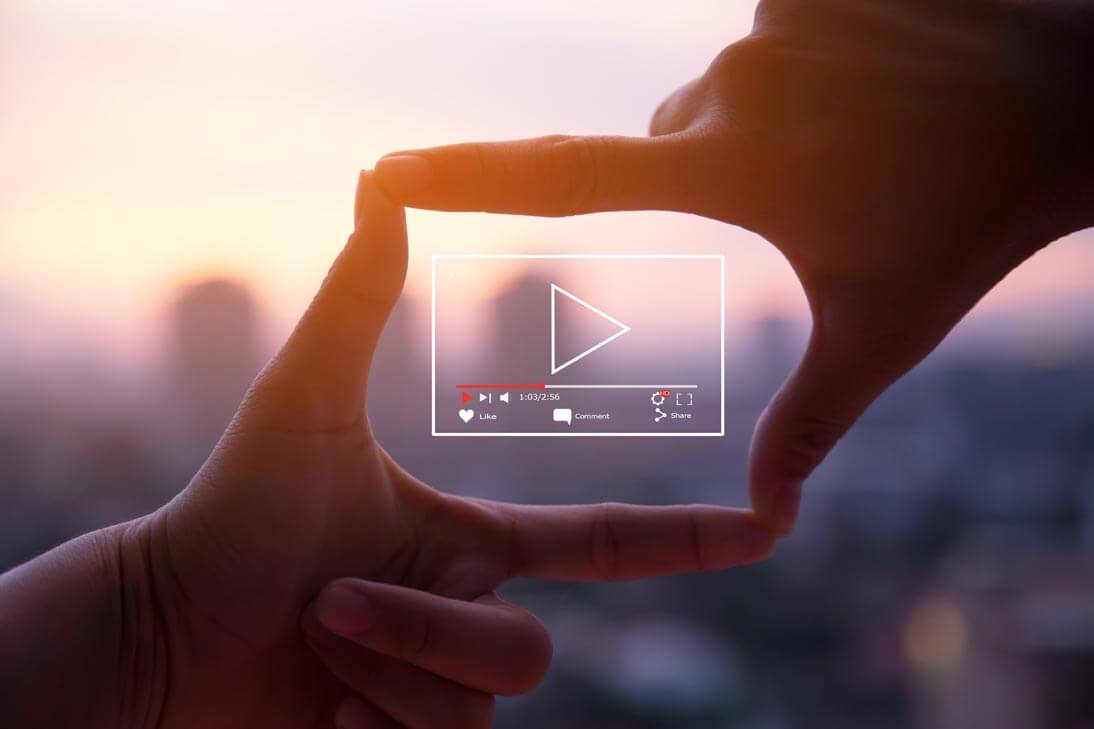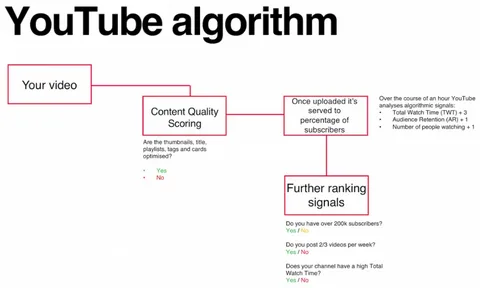The YouTube algorithm is a complex system that determines which videos are recommended to viewers across the platform. Its primary purpose is to keep users engaged by surfacing content they are likely to enjoy and watch. The algorithm is a closely guarded secret, but it is known to analyze a vast array of data points to make these personalized recommendations.
At its core, the YouTube algorithm is designed to maximize viewer engagement and retention. It evaluates signals such as a user’s watch history, search queries, location, and interactions with videos (likes, comments, shares) to understand their interests and preferences. This data is then used to curate a personalized feed of recommended videos tailored to each individual viewer.
The algorithm also considers video metadata, including titles, descriptions, tags, and thumbnails, to determine relevance and appeal. Additionally, it factors in performance metrics like view count, watch time, and audience retention to identify high-quality, engaging content that aligns with viewer interests.
While the exact formula is constantly evolving, the YouTube algorithm prioritizes videos that keep viewers watching for longer periods, encourage interaction, and foster a positive user experience. By continuously analyzing vast amounts of data, the algorithm aims to surface the most relevant and compelling content to each user, ultimately driving increased engagement and viewership on the platform.
Key Ranking Factors

The YouTube algorithm is a complex system that considers numerous factors when determining how to rank and recommend videos to viewers. While the exact algorithm remains a closely guarded secret, several key ranking factors have been identified through research and analysis by creators and industry experts. Understanding these factors can help content creators optimize their videos for better visibility and success on the platform.
One of the most crucial ranking factors is watch time. YouTube prioritizes videos that keep viewers engaged and watching for longer periods. The more time users spend watching a video, the higher it will likely rank in search results and recommendations. This metric encourages creators to produce high-quality, engaging content that captures and holds the audience’s attention.
Viewer engagement is another critical factor. YouTube closely monitors user interactions with videos, such as likes, dislikes, comments, and shares. Videos that generate positive engagement signals, like a high like-to-dislike ratio and active comments, are more likely to be favored by the algorithm. Conversely, videos with negative engagement signals, such as high dislike rates or a lack of comments, may be demoted in rankings.
Viewer retention, or the percentage of a video watched by viewers, is also a significant ranking factor. YouTube wants to recommend videos that keep viewers watching until the end. If a large portion of viewers abandons a video partway through, it may be seen as less engaging or relevant, negatively impacting its ranking.
Additionally, the algorithm considers factors like video freshness, relevance to the viewer’s interests and search queries, and overall channel performance. Consistently uploading new, high-quality content and maintaining a strong subscriber base can positively influence a video’s ranking.
By understanding and optimizing for these key ranking factors, content creators can increase their chances of having their videos prominently featured in search results, recommendations, and suggested video feeds, ultimately reaching a wider audience on YouTube.
Importance of User Engagement
User engagement metrics are among the most critical factors that the YouTube algorithm considers when ranking and recommending videos. YouTube wants to surface content that viewers find engaging, enjoyable, and valuable, as this keeps users on the platform for longer periods.
Likes, comments, shares, and watch time are crucial signals that indicate a video’s popularity and resonance with the audience. Videos with higher engagement rates are more likely to be promoted by the algorithm, appearing in recommended sections, search results, and users’ subscription feeds.
Likes demonstrate that viewers enjoyed and appreciated the content, while comments foster a sense of community and interaction around the video. Shares are a strong endorsement, as users are actively promoting the video to their friends and followers.
Perhaps most importantly, watch time is a direct measure of how engaging and captivating a video is. Videos that manage to hold viewers’ attention for longer periods are rewarded by the algorithm, as they contribute to increased overall watch time on the platform.
By consistently creating content that resonates with their audience and encourages high levels of engagement, creators can leverage the YouTube algorithm to gain greater visibility, reach, and growth on the platform.
Optimizing Video Content

Creating engaging and audience-retaining video content is crucial for success on YouTube. The algorithm heavily favors videos that keep viewers hooked and watching for longer periods. Here are some tips to optimize your video content:
-
Hook Viewers from the Start: The first few seconds of your video are critical. Use attention-grabbing introductions, teasers, or compelling visuals to capture viewers’ interest immediately and prevent them from clicking away.
-
Deliver Value and Substance: Provide informative, entertaining, or thought-provoking content that offers real value to your audience. Avoid fluff or filler content, and aim to deliver substance that keeps viewers engaged throughout the video.
-
Tell Stories and Evoke Emotions: Storytelling and emotional connections are powerful tools for engaging viewers. Craft narratives, share personal experiences, or tap into relatable emotions to create a deeper connection with your audience.
-
Use Visuals and Multimedia Effectively: Incorporate high-quality visuals, graphics, animations, or other multimedia elements to enhance the viewing experience and maintain viewer interest. However, strike a balance and avoid overwhelming or distracting viewers with too many elements.
-
Vary Pacing and Structure: Mix up the pacing and structure of your videos to prevent monotony. Alternate between different segments, such as interviews, demonstrations, or commentary, to keep viewers engaged and interested.
-
Interact and Engage with Your Audience: Encourage viewer participation by asking questions, soliciting feedback, or running polls or contests. This interaction can increase engagement and foster a sense of community around your channel.
-
Continuously Improve and Experiment: Analyze your video performance metrics, gather audience feedback, and experiment with different formats, styles, or techniques. Continuously refine and improve your content to better cater to your audience’s preferences and the algorithm’s requirements.
Remember, the YouTube algorithm prioritizes videos that keep viewers engaged and watching for longer periods. By following these tips and creating truly captivating content, you can increase your chances of being favored by the algorithm and reaching a wider audience.
Thumbnail and Title Strategies
Thumbnails and titles are the first things viewers see when scrolling through YouTube, making them crucial for attracting clicks and views. An eye-catching thumbnail and compelling title can make the difference between a video being watched or ignored.
Thumbnails
Thumbnails should be visually appealing, high-quality, and accurately represent the video content. Use bright colors, clear text, and relevant imagery to grab attention. Avoid cluttered or busy designs, as simplicity often works best. Consider using custom thumbnails instead of relying on YouTube’s auto-generated options.
Effective thumbnails often include:
- Close-up shots of faces with expressive emotions
- Text overlays with catchy phrases or teasers
- Relevant graphics or icons related to the video topic
- High-contrast colors and bold fonts for legibility
Titles
Titles should be concise, descriptive, and enticing. Aim for around 50-60 characters to ensure they display properly on various devices. Use keywords relevant to the video content to improve discoverability, but avoid keyword stuffing or clickbait tactics.
Compelling titles often incorporate:
- Numbers or lists (e.g., “5 Tips for Better Thumbnails”)
- Curiosity-inducing language (e.g., “The Secret to Viral Videos”)
- Emotional hooks (e.g., “You Won’t Believe These Editing Tricks”)
- Specific promises or benefits (e.g., “Grow Your Channel Fast”)
Remember, thumbnails and titles work together to grab viewers’ attention and entice them to click. Regularly test different combinations and analyze performance metrics to refine your strategies over time.
Consistency and Uploading Schedule
Maintaining a consistent uploading schedule is crucial for success on YouTube. The algorithm favors channels that regularly publish new content, as it indicates an active and reliable creator. By establishing a predictable release pattern, you build viewer expectations and loyalty, leading to higher engagement rates.
When viewers know when to expect new videos, they are more likely to return to your channel, increasing watch time and overall engagement metrics. Consistency also helps YouTube understand your content cadence, making it easier for the algorithm to promote your videos to the right audience at the optimal time.
Furthermore, a consistent uploading schedule demonstrates your commitment to your channel and audience, which can lead to increased subscriber growth and better rankings. Viewers appreciate creators who deliver quality content on a reliable schedule, as it shows dedication and professionalism.
To maximize the benefits of a consistent schedule, consider the following tips:
-
Establish a realistic schedule: Determine a frequency that you can sustain without compromising quality. It’s better to start with a modest schedule and gradually increase your output than to burn out from an overly ambitious plan.
-
Communicate your schedule: Let your audience know when to expect new videos, either through announcements, social media, or video descriptions. This builds anticipation and ensures your viewers are aware of your release schedule.
-
Stick to your schedule: Once you’ve established a pattern, do your best to adhere to it. Consistency is key, and deviating from your schedule can confuse both your audience and the algorithm.
-
Monitor and adjust: Regularly review your analytics to understand how your schedule impacts engagement and viewership. If necessary, make adjustments to better align with your audience’s viewing habits.
By prioritizing consistency and maintaining a reliable uploading schedule, you demonstrate your commitment to your audience and provide the YouTube algorithm with valuable signals about your channel’s activity and content quality, ultimately improving your chances of ranking higher and reaching a wider audience.
Viewer Retention and Watch Time
Viewer retention and average watch time per video are crucial factors that YouTube’s algorithm considers when ranking and suggesting content. The longer viewers stay engaged with your videos, the more likely YouTube will promote them to a wider audience. Here are some effective techniques to improve viewer retention and increase watch time:
1. Create Engaging Introductions: Capture your viewers’ attention from the very beginning with an attention-grabbing introduction. Use hooks, teasers, or intriguing statements to pique their curiosity and encourage them to keep watching.
2. Structure Your Content Effectively: Organize your videos in a logical and easy-to-follow structure. Use clear sections, timestamps, or chapter markers to help viewers navigate through your content effortlessly. This can prevent them from getting lost or losing interest.
3. Use Visuals and Animations: Incorporate visuals, graphics, animations, and other engaging elements throughout your videos. These elements can help reinforce your message, add visual interest, and keep viewers engaged.
4. Incorporate Storytelling: People are naturally drawn to stories. Weave your content into a compelling narrative or use storytelling techniques to make your videos more engaging and memorable.
5. Encourage Interaction: Prompt your viewers to interact with your videos by asking questions, encouraging comments, or suggesting actions they can take. This can increase their engagement and make them feel more invested in your content.
6. Optimize Video Length: While there’s no one-size-fits-all video length, aim for a duration that suits your content and audience. Longer videos can provide more value, but shorter videos may be better suited for certain topics or viewer attention spans.
7. Use Annotations and End Screens: Utilize annotations, end screens, and other interactive elements to encourage viewers to watch more of your content or take specific actions, such as subscribing or checking out related videos.
8. Analyze Audience Retention Data: YouTube’s analytics provide valuable insights into your audience’s viewing behavior. Study the audience retention graph to identify points where viewers tend to drop off and make adjustments to your content accordingly.
By implementing these techniques, you can enhance viewer engagement, increase average watch time, and ultimately improve your chances of being favored by the YouTube algorithm.
Subscriber Growth Tactics
Growing your subscriber base is crucial for success on YouTube, as the algorithm tends to favor channels with higher subscriber counts. Here are some effective strategies to gain more subscribers:
Collaborate with Other Creators: Collaborating with other YouTubers in your niche can expose your content to new audiences and potentially gain you new subscribers. Look for creators with a similar target audience and reach out to them for collaboration opportunities, such as guest appearances, joint videos, or cross-promotion.
Promote Across Social Media: Leverage your presence on other social media platforms to promote your YouTube channel and videos. Share teasers, highlights, or behind-the-scenes content on platforms like Instagram, Twitter, and Facebook, encouraging your followers to subscribe to your YouTube channel for more content.
Run Subscriber-Focused Campaigns: Periodically run subscriber-focused campaigns, offering incentives or giveaways to encourage viewers to subscribe. For example, you could offer exclusive content, merchandise, or other rewards for new subscribers during a specific campaign period.
Engage with Your Audience: Actively engage with your viewers by responding to comments, asking questions, and fostering a sense of community. This engagement can build loyalty and encourage viewers to subscribe to stay connected with your content and community.
Optimize Video Descriptions: Include a clear call-to-action in your video descriptions, encouraging viewers to subscribe to your channel. You can also include relevant links, hashtags, and other information to make it easier for viewers to find and subscribe to your channel.
Leverage End Screens and Cards: Use YouTube’s end screens and card features to prompt viewers to subscribe to your channel. These visual cues can be effective in reminding viewers to subscribe before they navigate away from your video.
Promote Evergreen Content: Identify your most popular and evergreen content, and promote it consistently to attract new viewers and potential subscribers. Evergreen content is content that remains relevant and valuable over an extended period, increasing the chances of gaining new subscribers over time.
Remember, building a loyal subscriber base takes time and consistent effort. By implementing these strategies and creating high-quality, engaging content, you can gradually grow your subscriber count and increase your visibility on the YouTube platform.
Responding to Algorithm Updates
YouTube’s algorithm is constantly evolving, and it’s crucial to stay informed about the latest updates and changes. By understanding how the algorithm works and adapting your content strategy accordingly, you can ensure that your videos continue to perform well and reach your target audience effectively.
One of the best ways to stay informed is to follow reputable sources and industry experts who closely monitor and analyze YouTube’s algorithm updates. Subscribe to their channels, newsletters, or blogs to receive the latest news and insights. Additionally, YouTube itself often releases official announcements and guidelines regarding algorithm changes, which can provide valuable information directly from the source.
When an algorithm update occurs, take the time to analyze how it might impact your content and audience engagement. Evaluate your existing content and identify areas that may need adjustment or optimization based on the new guidelines. For example, if the update prioritizes longer watch times, you may need to focus on creating more in-depth and engaging content that keeps viewers hooked for longer periods.
Furthermore, be proactive in adapting your content strategy to align with the algorithm’s evolving preferences. Experiment with different formats, topics, or styles that resonate with the new guidelines. Analyze your performance metrics and audience feedback to identify what works best under the updated algorithm.
Lastly, don’t be afraid to seek guidance from experienced creators or industry experts who have successfully navigated algorithm updates in the past. Their insights and strategies can be invaluable in helping you adapt and thrive in the ever-changing landscape of the YouTube algorithm.
Tools and Resources
YouTube provides several built-in analytics tools to help creators monitor and optimize their video performance. The YouTube Studio dashboard offers detailed insights into viewer engagement metrics, audience demographics, traffic sources, and more. Creators can leverage this data to identify trends, adjust their content strategy, and make informed decisions.
Third-party tools like TubeBuddy, vidIQ, and Morning Fame can also be valuable resources for YouTube creators. These platforms offer additional features like keyword research, competitor analysis, video optimization suggestions, and automated workflow management. While some tools offer free plans, paid subscriptions typically provide more comprehensive capabilities.
Social media analytics tools like Google Analytics, Twitter Analytics, and Facebook Insights can help creators track the performance of their cross-platform promotion efforts and better understand their audience’s behavior across different channels.
Additionally, there are numerous online communities, forums, and educational resources dedicated to helping creators navigate the YouTube algorithm and succeed on the platform. Joining relevant groups, attending webinars, or consulting with experienced YouTube consultants can provide valuable insights and strategic guidance.

